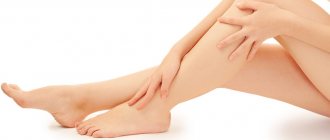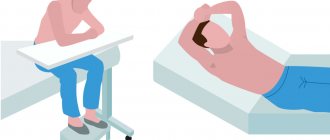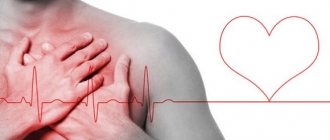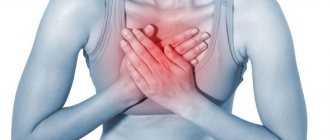Minor pain in the leg muscles is quite common. Problems with legs most often arise when playing sports, when working with loads on the legs or doing household chores. In addition, injuries are a common cause of leg pain. Problems in the legs can be minor or, on the contrary, serious and manifest themselves with symptoms such as pain, swelling, cramps, numbness, tingling, muscle weakness or changes in temperature and skin color. Symptoms often appear after exercise, daily activities and excessive stress. People in the older age group are more susceptible to developing leg problems as muscle loss occurs over the years. In childhood, leg problems can be caused by similar factors as in adults, or they can be specific. The causes of pain in the legs are divided into two groups: traumatic and non-traumatic. By localization - pain in the thigh, buttocks, pain in the lower leg and pain in the foot. The main and most common causes of leg pain.
- Injuries associated with overuse or repetitive motion (bursitis, tendinitis, plantar fasciitis).
- Muscle cramps.
- Schlatter–Osgood disease
- Juvenile idiopathic arthritis
- Growing pains
- Medicines (side effects)
- Restless legs syndrome
- Transient ischemic attack or stroke
- Obliterating peripheral artery disease
- Venous thrombosis.
- Pregnancy
- Crick
- Muscle rupture
- Injury to a muscle or lower limb
- Bone lesions
- Rupture of popliteal cyst (Baker's cyst)
- Joint diseases (osteoarthritis, SLE, rheumatoid arthritis, arthrosis)
- Varicose veins
- Obesity
- Night crumpies
- Fibromyalgia
- Infections
- Neurogenic pain (disc herniation, stenosis, disc protrusion, lumbosacral radiculitis)
- Diabetic polyneuropathy
Muscle cramps
Muscle cramps (cramps) are strong, painful contractions and tightening of muscles that occur suddenly, lasting from a few seconds to several minutes. Muscle soreness may persist for several hours after the clenching (cramp) episode ends. They usually go away on their own and do not require special treatment.
The cause of seizures cannot always be determined. Muscle cramps can occur under various conditions or types of physical activity such as:
- Exercise, injury or overuse of muscles. When a muscle is overfatigued, has poor elasticity or an incorrect load vector, it can cramp.
- Dehydration associated with exercise during hot weather can cause heat cramps. In addition, various conditions (vomiting, diarrhea or lack of water) can also cause cramps.
- Pregnancy. Cramps during pregnancy can occur due to a decrease in the amount of minerals in the body, such as calcium and magnesium, especially in the last months of pregnancy (when the formation of the fetal musculoskeletal system is completed).
- Exposure to low temperatures, especially when immersed in cold water.
- Some diseases (peripheral artery occlusive disease, kidney disease, thyroid disease), multiple sclerosis, etc.
- Medicines - some drugs can cause seizures (neuroleptics, diuretics). In any case, if there are recurring episodes of seizures, you should consult a doctor.
Neurogenic myalgia
Neuromuscular diseases, when muscle function is disrupted, i.e. damage to the muscles themselves or due to dysfunction of the neuromuscular junction, diseases of the spinal cord, damage to peripheral nerves or damage to the motor nuclei of the brain stem.
With osteochondrosis of the thoracic and lumbar spine, there may be plexopathies, radiculopathy, plexoradiculopathy. You are concerned about pain, limited movement, impaired sensitivity, muscle atrophy, paresis and paralysis may develop.
Progressive muscular dystrophies are genetic hereditary diseases and most often occur in childhood.
Inflammatory myopathies or myositis can occur due to inflammation or due to autoimmune diseases.
Mitochondrial myopathies are hereditary diseases, the cause of which is disruption of the functioning of mitochondria - the “power stations” of cells in which most of the ATP necessary for the cell is synthesized. This is a huge spectrum of diseases.
There are several different mitochondrial diseases with primary involvement of striated muscle or combined involvement of muscle tissue and the brain:
- — Kearns-Sayre syndrome is characterized by ophthalmoplegia, ataxia, muscle weakness, cardiac conduction disturbances, etc.;
- - MELAS syndrome - encephalomyopathy, lactic acidosis, stroke-like episodes;
Leber's optic neuropathy - acute loss of central vision in young men and many others.
Conditions associated with disruption of cellular energy are very common and are not limited to hereditary syndromes. Among them: chronic fatigue syndrome, migraines, cardiomyopathies, glycogenosis, connective tissue diseases, diabetes, rickets, hypoparathyroidism and many others.
The diagnosis of mitochondrial myopathies is based on morphological diagnosis and identification of the RRF phenomenon (“regged” red fibers, “torn” or “rough” red fibers).
Osgood-Schlatter disease
Osgood-Schlatter disease (sometimes also called Schlatter disease or osteochondrosis of the tibial tuberosity) is an inflammation in the upper part of the tibia, where the patellar tendons attach to the tubercle called the tibial tuberosity. This disease is often the cause of knee pain in adolescence (from 10 to 15 years), is associated with the growth of the musculoskeletal system, and as growth completes, the symptoms may disappear.
Osgood-Schlatter disease can cause pain, swelling, and tenderness in the area of the front of the knee, below the kneecap. As a rule, one knee is affected (sometimes it happens on both sides). Symptoms worsen when the tendon attached to the tibial tuberosity is stressed (for example, when jumping). The diagnosis is made on the basis of radiography. The main goal of treatment is aimed at preventing symptoms (reducing certain types of stress, immobilization during exacerbation, physiotherapy). Surgical treatment methods are rarely used.
4.Bemer therapy
In our medical practice, Bemer therapy has proven to be the most successful way to combat any type of pain. BEMER therapy is electromagnetic physiotherapy from Switzerland, the main goal of which is to improve blood circulation.
The Bemer device consists of three elements: an induction mattress aimed at general health improvement, a reinforced applicator - a device that allows you to influence a specific place, and a laser magnet, which has the strongest effect on the pain point
read more about Bemer therapy by following the link. If you want to get a consultation or make an appointment, you can do this using the feedback form or by phone: +7-495-212-08-85
Sign up for a consultation
Juvenile idiopathic arthritis
Juvenile idiopathic arthritis, often called juvenile rheumatoid arthritis or juvenile chronic arthritis, is a childhood disease characterized by inflammation of the joints, which become swollen and painful (and therefore impair joint mobility). It manifests itself in children as pain in the joints, impaired gait, due to decreased mobility in the joints and stiffness in the joints, usually in the first half of the day, with regression within 1-1.5 hours and after normal physical activity. The causes of this disease are not entirely clear. Most researchers believe that the disease is caused by a combination of factors that cause excessive activation of the immune system. There are several types of juvenile arthritis. The division into types is based on the number of joints involved in the process during the first 6 months from the onset of the disease, the area of the body where the disease manifested itself, and the presence of other symptoms. Types of juvenile arthritis: oligoarthritis (affects no more than 4 joints), polyarthritis (affects 5 or more joints), rheumatic-positive and rheumatic-negative (depending on the presence of rheumatic factor in the blood), systemic (accompanied by rashes on the body, fever and lesions). eye).
Growing pains
Pain in the legs occurs with growing pains and is often found in children and adolescents. Most likely, pain manifestations are associated with uneven growth of muscles, bones and soft tissues. The pain is usually localized in the thighs or calf muscles and usually appears in the afternoon. The duration of the pain can be 1-2 hours. Growing pain is not accompanied by other symptoms (fever, swelling). Over time, the symptoms disappear on their own. It is possible to use massage and sometimes paracetamol. Aspirin is not recommended before age 20 due to the possibility of developing Reye's syndrome.
What does varicose veins of the foot look like?
At the very beginning of the development of pathology, one feels heaviness and fatigue in the legs by the end of the day. Next, aching pain may appear, a sensation as if the leg is bursting, and the foot swells. All these symptoms may go away on their own after rest. But you shouldn’t put off going to the doctor. If varicose veins of the feet are not treated at the initial stage, the disease will begin to progress. First, spider veins and spider veins will appear, then varicose veins will also affect large veins. At this stage, the pain becomes constant, the legs begin to swell more, and muscle spasms appear.
Medicines
Some medications can cause leg problems due to side effects. Combination with smoking or drinking alcohol increases the risk of drug side effects. The main groups of drugs that can cause leg problems:
- Drugs that cause blood clots (for example, contraceptives)
- Neuroleptics (aminazine, haloperidol)
- Beta-2 receptor agonists (terbutaline or albuterol)
- Antihypertensive drugs (nifedipine, amlodipine or nicardipine)
- Statins are drugs that lower blood cholesterol levels (simvastatin or atorvastatin).
- Estrogens
- Lithium preparations
- Diuretics (Lasix and others)
- Opiates
- Steroids
If you are taking medications (especially long-term), you should inform your doctor about the occurrence of pain or cramps in the legs.
Restless legs syndrome
Restless legs syndrome is a condition in which the patient experiences discomfort from the position of the legs and, sometimes, an irresistible urge to move the legs. This syndrome can lead to sleep disturbances and interfere with daily life.
Patients describe their sensations as the touch of needles in their legs, and sometimes as nagging pain. Changing the position of the legs brings temporary relief. Most often, these sensations occur in the evening, when a person is trying to relax or go to bed. The cause of this syndrome is not known. Certain medications (such as antidepressants), pregnancy, or iron deficiency (anemia) may cause this syndrome. Restless legs syndrome is treated with drugs that increase dopamine levels in the brain (levodopa) or anticonvulsants (gabapentin) to control leg movements and improve sleep. Opiates are extremely rarely used.
Angiography
To resolve the issue, surgical tactics require information about the patency of the arteries of the affected limb. The choice of technique for restoring blood circulation depends on the condition of the inflow pathways to the affected limb and the vascular bed below the site of blockage. In addition, angiography can distinguish embolism from thrombosis against the background of atherosclerotic narrowing. During an angiographic examination, endovascular treatment can be undertaken in the form of thrombectomy and angioplasty of the affected segments or local thrombolytic therapy can be performed.
Arterial embolism is an acute blockage of a vessel by a thrombus or other object brought from other parts of the vascular bed. Most often, vascular surgeons deal with thromboembolism from the heart cavity during a heart attack or atrial fibrillation, from the cavity of the aneurysm of the vessel overlying the blocked artery.
Consequences of acute cessation of blood flow
The sudden cessation of blood flow leads to the phenomenon of acute ischemia. The organs and tissues that are supplied by this artery lack nutrition and oxygen, so they begin to slowly die. The most specialized tissues are affected first—nervous, muscle, and finally skin. The body tries to restore blood circulation by opening additional bypass pathways for blood flow, so sometimes tissue death is stopped. But the likelihood of such an outcome is low. In any case, acute ischemia leads either to gangrene or to the development of chronic circulatory deficiency - critical ischemia.
Transient ischemic attacks
Transient ischemic attacks are a temporary disruption of the blood supply to the brain. They are harbingers of a stroke. The only difference from a stroke is that the symptoms gradually disappear. The following symptoms should alert you:
- Sudden numbness, tingling and weakness in half the body or limb
- Gait disturbance
- Impaired perception of reality
- Speech Impairment
- Strong headache.
If these symptoms occur, seek emergency medical attention
Obliterating peripheral artery disease
PADS is a permanent process of narrowing or blockage of the arteries that supply oxygen-rich blood to various organs, including the lower extremities.
The main cause of occlusive lesions of the peripheral vessels of the lower extremities is the accumulation of cholesterol, calcium and other substances on the walls of the arteries (atherosclerosis). The narrowing of the artery lumen leads to a decrease in the supply of arterial blood to the leg muscles, which is especially evident during physical activity. When the muscle is at rest, the blood supply may be adequate.
The main symptom of obliterating disease of the arteries of the legs is pain in the calf muscles, thighs and buttocks, which appear after physical activity (such as climbing a hill or stairs, running, walking). This pain is called intermittent claudication. This usually occurs after a certain amount of movement and disappears after rest. As the disease progresses, symptoms appear with minimal physical activity. In addition to pain, patients are often concerned about: decreased muscle strength in the legs and balance when standing, numbness in one or two legs, and the appearance of ulcers that heal slowly. Treatment is usually conservative. In case of severe disruption of blood supply, surgical treatment methods are indicated.
Physiological edema
Swelling of the legs can be caused by physiological reasons, that is, be a consequence of special circumstances affecting a healthy body, and not a manifestation of a disease. These reasons include:
- salty food. Salt binds water. And if you eat a lot of salty foods, especially at night, you may notice swelling in the morning;
- alcohol. Alcohol also retains water. Therefore, after drinking alcohol, a person looks puffy. The problems are not limited to the face; the legs can also swell;
- hot weather. In the heat, blood vessels dilate as the body tries to normalize heat exchange. More blood flow means the risk of congestion and swelling in the legs increases;
- prolonged sitting or standing. If the legs are in one position for a long time, the blood stagnates in them, which leads to swelling. The worst thing is to sit with your legs crossed. Standing in one place for a long time is also not useful. Swelling of the legs is typical for people in standing professions - hairdressers, salesmen, cooks;
- uncomfortable shoes. If shoes disrupt normal blood circulation in the foot (high heels, narrow arches, tight straps), wearing them will lead to swelling.
Venous thrombosis
The occurrence of pain during thrombosis (blockage of a vein with a blood clot) is promoted by inflammation of the vessel wall or surrounding tissue. In addition, impaired outflow can lead to swelling and discoloration of the skin (pallor, cyanosis, redness). Pallor can be detected in the early stages of thrombosis of the veins of the iliofemoral region. Cyanosis is caused by congestive hypoxia and, as a rule, occurs with obstruction of the proximal veins of the leg. Pain during thrombosis can be aching, sharp or dull, intense and moderate. Often the pain intensifies when walking or carrying heavy objects. Pain may be relieved by lying down with your legs elevated. With superficial vein thrombosis, diagnosis is not difficult. If there is a suspicion of deep vein thrombosis, then objective research methods are necessary.
Ultrasound duplex scanning
Ultrasound duplex scanning allows you to determine the patency of the arteries, localize the site of blockage of the vessel and the state of blood flow below the site of occlusion. Often, in acute ischemia, this diagnosis is enough to determine treatment tactics and send the patient to the operating table. With an embolism or rupture, the arteries below the blockage are usually empty or thrombosed, and blood flow in them is not detectable. Blood flow in the veins is sharply slowed down. With thrombosis, blood flow can be detected below the site of blockage, but its speed is sharply reduced; most often, blood flow through the main vessels cannot be detected, but blood flow can be seen through collaterals. As a rule, this is due to
Pregnancy
Pain and tenderness in the lower leg (less often in the thigh) can occur during pregnancy. In pregnant women, pain may be accompanied by swelling of the lower leg and thigh (both one and both limbs). The causes of pain in the legs in pregnant women are not entirely clear. On the one hand, this is explained by a violation of the outflow from the venous network of the lower extremities due to the fetus. On the other hand, a decrease in electrolytes in the blood contributes to the appearance of muscle cramps, which serve as one of the sources of pain. Unilateral swelling and pain in the limb may be associated with compression of the iliac artery by an enlarged uterus.
What are the symptoms of pelvic varicose veins?
If venous blood stagnates in the pelvic area, this can lead to the appearance of varicose veins in this area. It can stagnate due to sedentary work, mechanical compression of the veins by the enlarged uterus, and uncontrolled use of hormonal drugs. The cause of the appearance of dilated veins in the pelvic area can also be poor nutrition, constipation, hernias, problems in the genitourinary area, pathologies in the pelvic organs, nervous disorders and insomnia.
Most often the disease occurs in women. Pregnant women and menopausal women are at risk. The pathology manifests itself as pain in the perineal area, which becomes more intense after hypothermia or a long stay in a sitting position. Also, venous tubercles form in the perineal area, the process of urination becomes painful, and unpleasant sensations are observed during and after sexual intercourse.
All these signs require immediate contact with a specialist, because without adequate therapy, varicose veins of the small pelvis are aggravated by complications: thrombosis, thrombophlebitis, trophic ulcers. Pathology is diagnosed mainly by ultrasound examination, if there are no external signs yet.
Crick
Muscle pain can appear after fast walking, running, playing sports, or walking in poorly fitting shoes. As a rule, discomfort occurs immediately after exercise or after 12-24 hours. Most often, pain occurs in the legs, sometimes in the hips. Possible pain on palpation. Sometimes swelling of the lower leg occurs. If there is a clear connection with physical activity and the pain is bilateral, then the diagnosis is beyond doubt. In cases where the pain is one-sided, it is necessary to exclude possible venous thrombosis using objective diagnostic methods.
Muscle rupture
Most often, muscle ruptures occur in the lower leg (possibly in the thigh). A rupture occurs as a result of a sudden stretch or contraction of a muscle. Typically, a small section of muscle is torn where it connects to the tendon. But there are also large ruptures, up to separation of the muscle from the tendon or separation of the tendon. Muscle rupture occurs mainly when the limb is sharply flexed in the direction opposite to the acting force. The rupture is accompanied by acute pain immediately after excessive stress. The pain may subside for a while, but as the hematoma grows, the pain will gradually intensify. Swelling occurs in the area of the damaged muscle and range of motion is limited.
Bone damage
Damages to the bone tissue of the lower extremities (tumors, subperiosteal hematomas, fractures) may be accompanied by pain, tenderness to the touch, and swelling of the limb. Clinical manifestations may be similar to venous thrombosis. It can be especially difficult to diagnose a hip fracture in older people (the fracture is often accompanied by swelling of the lower limb). Considering the involutional changes in the central nervous system (cerebral vascular sclerosis), it is sometimes difficult to collect an anamnesis in this category of patients. In addition, elderly people often have a combination of a femoral neck fracture with venous thrombosis.
Rupture of popliteal cyst (Baker's cyst)
The fluid contained in a Baker's cyst, when ruptured (in the case of injury, arthritis or surgery in the knee joint), can flow down into the intermuscular space and cause an inflammatory reaction. This may manifest itself as pain, swelling in the lower leg, tenderness on palpation and resemble the picture of venous thrombosis. Rupture of a Baker's cyst can occur without provoking reasons. The diagnosis can be made based on radiography. But the possible combination of cyst rupture and venous thrombosis requires first of all the exclusion of thrombosis.
Diagnostics
First of all, to diagnose the cause of pain, the doctor needs to get answers to a number of questions:
- Localization of pain
- Presence of pain in one or two limbs
- Nature of pain (sharp, dull)
- Dependence of pain on time of day
- Dependence of pain intensity on physical activity
- Possibility of reducing pain when raising legs
- The presence of other symptoms (fever, weakness, lower back pain).
In addition, the doctor will conduct a physical examination (visual examination, palpation, various tests). Instrumental examination methods:
- Laboratory research
- Ultrasound of the vessels of the lower extremities (Dopplerography of veins and arteries)
- Arteriogram
- Scintigraphy
- MRI
- CT
- Radiography
Treatment
Treatment of leg pain directly depends on the disease and can be either conservative (drug treatment, intra-articular injections, physiotherapy, acupuncture, exercise therapy, orthotics) or surgical. The following recommendations can be preventive:
- No smoking
- Don't abuse alcohol
- Monitor blood sugar levels (if you have diabetes)
- Control cholesterol levels
- When exercising, a mandatory warm-up before and sufficient rest after exercise
- Drinking enough fluids during exercise.
Author: V.I. Dikul
“Female” causes of leg swelling
In women, swelling of the legs can be caused by special reasons:
- premenstrual syndrome. Before menstruation, the hormonal balance is disrupted - the relative content of estrogens increases, and estrogens retain fluid in the body;
- pregnancy. During pregnancy, a woman's body produces a large amount of progesterone, which reduces vascular tone. This contributes to stagnation of blood in the legs. The growing fetus can compress large vessels, which also causes edema - this reason becomes significant in the later stages. Swelling can also be a manifestation of gestosis (late toxicosis of pregnancy).











